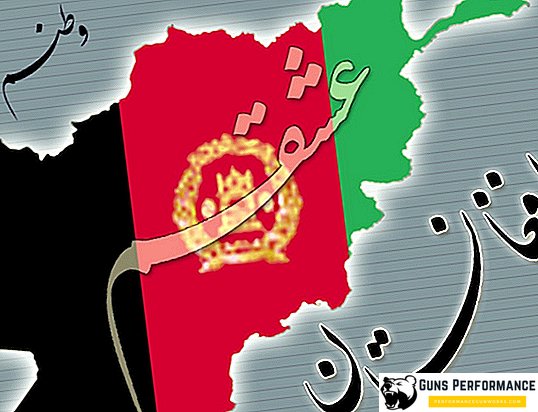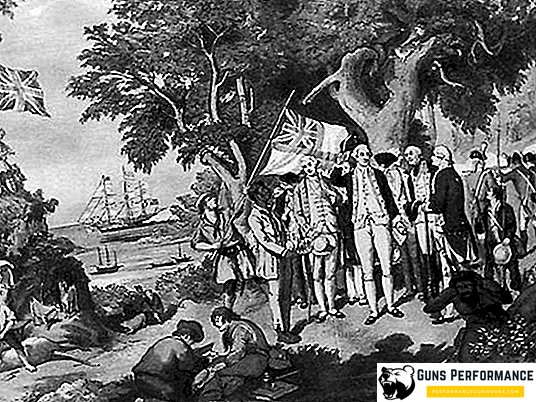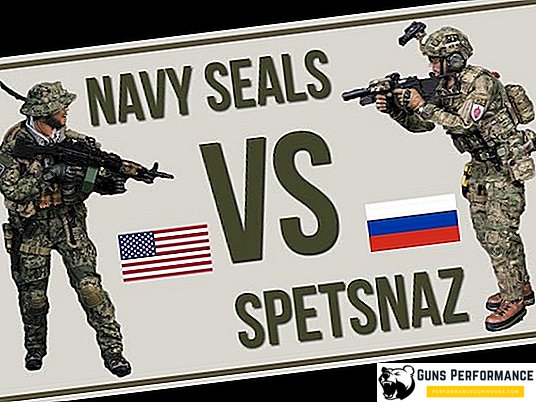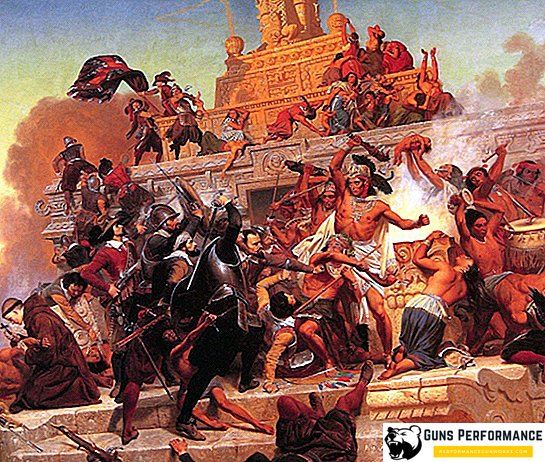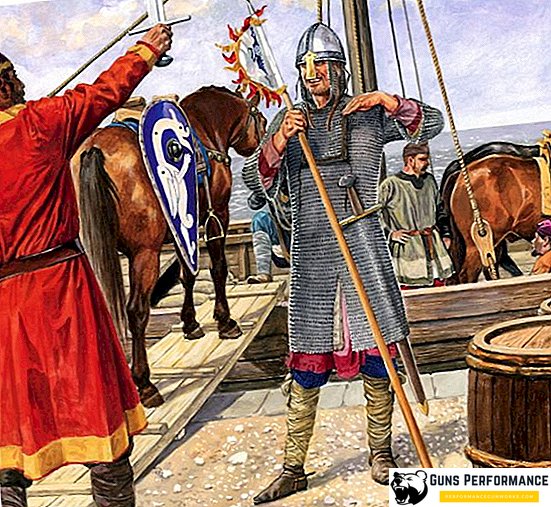
Starting from the 9th century, bandits of Vikings, who terrify the local population, penetrate into Europe. Since the Vikings mostly came from Scandinavian countries, especially from Denmark, after a close acquaintance with them, they began to be called Danes. History says that at about the same time, the Varangians began to appear on the native Slavic lands, which are now considered to be the same Vikings.
If you carefully analyze all the documents that have come down to us regarding the appearance and vocation of the Varangians in Russia, you will notice a strange inconsistency. If the Vikings in the same Europe were hated, then among the Slavs they were treated with respect to the Vikings, as a rule. This raises serious doubts about the authenticity of the version that the Varyag is the same Viking.
The appearance of the Vikings in Russia

The first mention of the Vikings are found in the Tale of Bygone Years. Representatives of this people appeared in the Slavic lands from about the 9th century. As a rule, at that time the Varangians were rich merchants who came to Russia in large quantities. In the large Slavic cities of these merchants there were so many that they formed large communities, which often prevailed even over the local population.
After in the 10-11 centuries the Russian princes began to vigorously call the Varangian troops to their service, the number of these foreigners increased even more. So much so that Novgorod, originally considered a Slavic city, after the mass vocation of the Varangians, began to be considered a Varangian city. A huge number of Varangian merchants and mercenaries were repeatedly recorded in ancient Kiev documents.
Even one of the first campaigns of the squads of the princes Askold and Dir against Tsargrad was made possible by the Varangian militia assembled in Kiev. By the way, according to legends, even the capital of Russia was founded precisely by the Vikings. The cult of Perun, who was the main god of the Vikings, confirms these traditions.
Mention of Varyags in ancient European history

When analyzing the rare extant sources of Europe from the early Middle Ages, one can find references to the Vikings dating from the beginning of the 9th century. Exploring these documents, one can see that the Varygs came to Europe from the territory of the Slavs long before the calling of the Varangians to reign in Novgorod.
For example, in 839, messengers from the people, called Rus, arrived in Constantinople. After solving their problems, they were sent along with the Byzantine embassy to Germany, where they met with Louis the Pious. German sources clearly indicate the Swedish origin of the Slavic embassy, which hints that the ambassadors were pure-blood Varangians.
Around the same time, the Vikings are mentioned in Arab sources. Eastern chroniclers described in detail the military campaigns of Russia on the shores of the Black Sea. The same warriors who attacked the coasts often came to the East for commercial purposes. At the beginning of the 10th century, the Varangians became so accustomed to the Black Sea that in the Byzantine documents it was often called “Russian”, since apart from the Varangians, practically no one else in it so massively swam.
The secret of the origin of the Vikings and Russia

Old Russian Vikings, most likely, were not Slavs. It was a kindred Scandinavian tribe. If we again refer to the Tale of Bygone Years, then there the Varyags are all Germanic peoples, such as:
- Noregi;
- Are given;
- Goths;
- Angles and so on.
Most likely, the tribes who lived on the southern and northern shores of the Varangian (Baltic) Sea were called Varangians. In the 11th century, the Byzantines called the Varangians mercenaries, who served as the personal guard of the emperor.
As for the origin, then according to one of the versions, it is believed that the Varangians are a distorted word “varang”, the origin of which is not completely clear. This word was used in the ancient Scandinavian language.
According to another version, which is also not confirmed, the first Vikings were so named because they revered the wolf as their patron. Moreover, this name was given to them by other nations. Varg is the monstrous wolf Fenrir from Norse mythology. Vargami also called his sons - Skol and Khati. It turns out that the Vikings are the children of the Vargs. Unlike the Slavic peoples, who belonged to the forest wolf as a thief, the Scandinavians worshiped polar wolves, which were much larger than the forest wolves.
German sources of the 11th century, telling about the Polish campaign on the Russian lands, also speak about the non-Slavic origin of the Vikings. German warriors told chroniclers that there are many people in Russia who are Danes. You can be sure that the Germans would definitely not confuse their fellow Danes with other nations. In addition, ancient tombstones are often found in Sweden, on which there is information about naval journeys to Slavic lands.
The most common ancient Scandinavian sources and sagas, which can be compared with the Russian chronicles about the Vikings, directly indicate that the Scandinavians often went to Gardaric. It is interesting that Gardarika, that is, the “kingdom of cities” of the saga is called ancient Russia. This indirectly indicates that the big trade Slavic cities were founded by the Vikings.
In addition, all the legends about the vocation of the Vikings to Russia claim that it was they who founded the state, called Russia. The first Varyag, called to reign with his retinue and brothers Sineus and Truvor, is known to all under the name of Rurik. If we compare this name with the Scandinavian sources, it becomes clear that this is none other than Hrerek. Other Russian princes also have distorted Scandinavian names:
- Truvor is Thorvardr;
- Oleg - Helgi;
- Olga - Helga;
- Oskold - Hoskuldr;
- Deer - Dyri.
In the 10th century, all the Arab and Byzantine chronicles of the Vikings clearly distinguished between these two peoples, like the Slavs and the Vikings. And the name Russia originally meant not a state, but a separate warlike people who dominated the Slavs. And the battles of the first Russian princes with the Drevlyans and other indigenous Slavs indirectly indicate that these are completely different nations.
Formation of the ruling military trading elite in the country

It was the Vikings, who had Scandinavian origin and became the basis for the emergence of the military-trading class in major Slavic cities. Although many authors often associate the Vikings with the Vikings, these are completely different concepts. The Vikings is a union of warriors, consisting of representatives of different nations. At its core, this is a prototype of the Zaporizhian Sich, that is, a huge predator windbreaker. The maximum that only the Vikings could do useful to others is to engage in the service as mercenaries or guards.
In the battles of the warriors of Norway proved to be the best fighters of their time, but as for honesty, the Normans and the Norwegians became famous as insidious and dishonest opponents. Often for the sake of gain, the Scandinavian warriors who served the prince could refuse to fight or even attack their employer.
The Varangians who came from the shores of the Baltic Sea did not cause negative attitudes among the Slavs, since they mostly traded honestly. Rich merchants, who were armed to the teeth and knew how to handle weapons perfectly, were usually bought in Russia with furs, after which they went to distant Byzantium in order to profitably sell their goods. From the Byzantine markets, fabrics, spices, clothing, shoes and other goods came to Russia.
In addition, in the surviving legends and legends, people from the Russian sea, which was called at that time Variazhskiy, often appeared as bold robbers. Many legends about remote merchants, who on the way did not disdain to rob or even kill a foreign merchant, perfectly characterize the Varangians. The fact that the Varangians were engaged in trade is evidenced by some of the words preserved in the Russian lexicon. Varyag in imperial Russia was often called a petty trader, and the expression "bling" meant engaging in petty bargaining.
Often, the fighting squads of the Varangians pretended to be merchant caravans, while no one suspected that the Varangian merchants were armed to the teeth. Here are some historical facts that confirm this:
- Prince Oleg was able to lure Askold and Dir from Kiev, pretending to be a rich merchant with guards;
- The great Scandinavian hero, Saint Olaf, who served the Grand Duke Vladimir Svyatoslavovich for many years, also pretended to be a merchant when returning home.
As the Novgorod chroniclers write, the Varangians began their way from mercenaries and guards of trade caravans, and after becoming rich they themselves became merchants. Thus, it was the Vikings who formed the class of merchants-warriors who developed trade in Russia.
Establishment of Varangian rule in Russia

According to ancient sources, the Vikings, after the formation of trade armed clans in the cities, began to gradually seize power in their hands. Over time, the cities that were ruled by the Varangian princes turned into powerful armed points, around which the local population was grouped. Since before that the Slavs were under the yoke of the Khazars and paid them tribute, the unauthorized seizure of power by the Varangians was regarded by the local population, almost as a deliverance.
The Varangian princes, unlike the greedy Khazars, did not rob local residents. The Tale of Bygone Years tells that the princes Askold and Dir, coming to Kiev, and learning that the local people paid tribute to the Khazars, remained in it to rule. Then they gathered a strong army, consisting mainly of fellow tribesmen, and began to seize the nearby Polanska towns. Soon all these lands recognized the power of the Varangian princes.
Prince Oleg, who seized power in Kiev, called on all the surrounding Varangians and local glades to arms, proceeded to further expand the sphere of influence. So he managed to subdue Smolensk Krivichy. The local residents did not particularly resist, although the same Drevlyans for a long time did not want to obey the Varangians.
Education Varangian principalities

Gradually, the Varangian power in Russia significantly strengthened. The newcomers began to assimilate with the local population, since almost all of them took wives and concubines among the Slavs. The seizure of power in large cities took place suddenly. First, the Varangians fenced off their trade courtyard from prying eyes, and began to accumulate weapons and strength. At one point, the merchants turned into warriors, and the local leadership was displaced or killed. To resolve this issue, the Varangians had only one strong squad.
Naturally, this situation did not like the Kiev princes, who gradually began to consider themselves to be indigenous Slavs. This marked the beginning of princely strife, which tormented the Russian lands for many centuries. In the struggle with each other, the princes did not disdain to invite not only hired Varangian troops, but also Viking Scandinavians.
True, the Scandinavians did not lose their profit, and often at the most crucial moment could fly over to the side of the enemy or kill their employer. However, often these methods have proven to be quite effective. For example, Prince Vladimir, who became famous for having baptized Russia, called from the sea a huge number of Vikings and Vikings. With their help, he wanted to defeat his brother Yaropolk, who was a prince of Kiev.
It cannot be said that Vladimir did not know the disposition of the Scandinavians, as he was married to the daughter of one of the famous Yarlovs at that time. But even Vladimir nearly fell into a trap, when attracted by the stories about the infinite riches of Kiev, the Vikings demanded to give them the city for plunder. "Our city, and we wish to take something, but you do not wish, then we will take it ourselves!", - with these words they answered the prince. Leaving only his Varangian squad and his father-in-law Vikings, Vladimir sent the rest of the greedy Scandinavians to serve in Tsargrad.
Some of the most intelligent Varangian princes not only captured cities, but also formed whole principalities. In the 9th century in Russia there were several of them:
- The Novgorod principality of Rurik (Hrek Yarl) was the most famous;
- Prince Sineus settled on White Lake;
- In Izborsk Prince Truvor;
- Askold - in Kiev.
In the 10th century, the Polotsk and Turov principalities appeared. It can be said for sure that there were much more such principalities, but they were not mentioned in the chronicles in any way. With the strengthening of the power of the Kiev princes, the other Varangian principalities gradually lost their power and became part of Kievan Rus.

There are still many white spots in the history of the Vikings. It is not clear where exactly this people came from, and why he came to the original Slavic lands. Perhaps modern archaeologists will find the old Varangian settlements in the Scandinavian countries, and this will help to uncover the mystery of the origin of this people.



